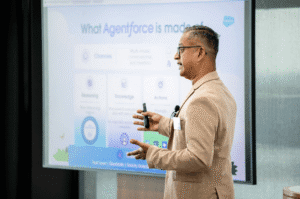- Services
Technology Capabilities
Technology Capabilities- Product Strategy & Experience DesignDefine software-driven value chains, create purposeful interactions, and develop new segments and offerings.
- Digital Business TransformationAdvance your digital transformation journey.
- Intelligence EngineeringLeverage data and AI to transform products, operations, and outcomes.
- Software Product EngineeringCreate high-value products faster with AI-powered and human-driven engineering.
- Technology ModernizationTackle technology modernization with approaches that reduce risk and maximize impact.
- Embedded Engineering & IT/OT TransformationDevelop embedded software and hardware. Build IoT and IT/OT solutions.
- Industries
- GlobalLogic VelocityAI
- Insights
BlogsDecember 16, 2024Gene LeybzonAccelerating Digital Transformation with Structured AI Outputs
This code produces the following output that can be imported into the candidate trackin...
 BlogsOctober 30, 2024Yuriy Yuzifovich
BlogsOctober 30, 2024Yuriy YuzifovichAccelerating Enterprise Value with AI
Discover how financial services integrations are transforming from standalone offerings...

- About Us
Press ReleaseGlobalLogicSeptember 23, 2025Hitachi agrees to acquire German data and AI services firm ...
Strengthening GlobalLogic’s data and consulting capabilities and expanding footprint in...
 Press ReleaseGlobalLogicSeptember 10, 2025
Press ReleaseGlobalLogicSeptember 10, 2025GlobalLogic and Ericsson Deploy Private 5G Network at Hitachi ...
The new infrastructure is the digital backbone of the Hagerstown plant, enhancing effic...

- Careers
Published on June 25, 2025Building the Future of Financial Services: Data, AI & Cloud-Native Transformation
ShareRelated Content GlobalLogic17 November 2025
GlobalLogic17 November 2025 GlobalLogic Marketing13 November 2025View All Insights
GlobalLogic Marketing13 November 2025View All Insights Yuriy Yuzifovich11 November 2025Recommended authorsSenior Vice President & Head of EMEAVice President & Consumer Business, Americas GlobalLogicView all authorsVice President, Financial Services & Consumer Business CTO, Americas & UKI
Yuriy Yuzifovich11 November 2025Recommended authorsSenior Vice President & Head of EMEAVice President & Consumer Business, Americas GlobalLogicView all authorsVice President, Financial Services & Consumer Business CTO, Americas & UKILet's start engineering impact together
GlobalLogic provides unique experience and expertise at the intersection of data, design, and engineering.
Get in touchAI-Powered SDLCGenAIFinancial ServicesExplore how Code, Capital, and Change are reshaping financial services—and why engineering intelligence, adaptability, and value flow are the future of transformation. Discover the 3Cs.
The financial services industry has reached a point of no return. The last decade was about experimenting with digital tools and artificial intelligence, launching isolated innovations. The next decade will be about engineering fully intelligent, adaptive institutions from the ground up.
The difference between leaders and laggards will come down to three things: how well they harness data, how deeply they embed AI, and how quickly they shift to cloud-native architectures.
Across financial sectors, the signals are clear:
- Banks are investing: 82% now allocate moderate-to-high levels of their tech budgets to AI initiatives (KPMG).
- Fintech is scaling: over three billion users now rely on digital payments globally (Statista).
- Cloud adoption is accelerating: cloud infrastructure spend grew 20% year-over-year in 2024 (Canalys).
But stitching together AI pilots and cloud migrations isn’t a strategy.
Financial institutions must reengineer their foundations, architecting for intelligence, resilience, and speed. Here’s how the most forward-looking organizations are doing it.Rebuilding Financial Services Around Data
Data is no longer a back-office asset. Today, it’s the lifeblood of how financial institutions compete, comply, and grow. And yet most banks, insurers, and payments providers are still struggling to unlock their data’s potential.
The top challenge in achieving AI readiness, according to 45% of respondents to a recent MIT Technology Review survey, is data integration and pipelines. Without reliable, real-time data, AI efforts stall, compliance risks rise, and product innovation slows.
The stakes are high:
- Financial planning models become inaccurate and reactive.
- Fraud detection lags behind increasingly sophisticated threats.
- Embedded finance and omnichannel personalization initiatives underperform.
Tomorrow’s financial leaders are treating data as a product, not a byproduct; one engineered for real-time decision-making, regulatory transparency, and rapid innovation. Unified enterprise data platforms (EDPs) are becoming the default operating system for intelligent financial services, not as optional upgrades but as critical enablers of growth.
Leading firms are eliminating silos, embedding governance, and activating data as a living, competitive asset. In doing so, they’re creating the foundation for real-time, AI-driven financial ecosystems.
Turning Regulatory Mandates into Experience-Driven Innovation
In financial services, regulatory frameworks like GDPR, CCPA, and open banking aren’t just compliance checklists; they can serve as accelerants for experience-led transformation.
Institutions that view data transparency, consent, and auditability as building blocks for solutions that meet clients’ needs are creating more responsive, trusted, and user-centric platforms. That design choice pays off in faster product cycles, stronger data integrity, and experiences that customers trust from the start.
This isn’t about meeting the minimum. It’s about using regulatory requirements as a blueprint for better systems; for platforms that flex with change, scale with demand, and earn loyalty through design. Compliance becomes a catalyst, not a constraint.
Trust isn’t a feature to bolt on later. It’s engineered into data models, consent workflows, and audit trails—so platforms can adapt fast without sacrificing transparency. That’s what turns compliance into a product advantage.
AI: From Pilot Programs to Platform Strategy
The era of isolated AI experiments is over. The real question now is not whether AI can deliver value in financial services; it’s how to operationalize it across every business line, customer journey, and compliance process.
Yet adoption is still at an early stage. Only 23% of FP&A professionals report using AI regularly, while 40% remain in testing phases. That gap between ambition and execution represents a major risk—and a major opportunity.
According to KPMG’s Intelligent Banking study:
- 80% of banking executives believe AI will define the next generation of competitive advantage.
- 62% expect a moderate to very high ROI from AI initiatives.
But real transformation won’t be built on isolated chatbots or narrow predictive models. It demands engineering AI into the very core of financial platforms, enabling smart automation, regulatory resilience, and continuous learning at enterprise scale.
VelocityAI, GlobalLogic’s platform-of-platforms for industrialized AI adoption, helps financial institutions move from proofs-of-concept to embedded intelligence, powering onboarding workflows, fraud monitoring, trading algorithms, and financial planning systems across the enterprise. As clients increasingly explore agentic AI—systems capable of making autonomous decisions within set parameters—VelocityAI provides the architecture to support that evolution, combining governed AI pipelines with modular design and adaptive feedback loops.
Want to understand how agentic AI is reshaping enterprise platforms? Read our deep dive on building reliable, autonomous systems at scale.
The Danger of Fragmented AI Adoption
Without a cohesive platform strategy, AI investments risk becoming fragmented experiments, delivering short-term wins but compounding long-term complexity. Siloed chatbots, isolated predictive engines, and disconnected automation pipelines add operational friction and stall innovation.
Real competitive advantage comes when financial institutions industrialize AI adoption. They’re embedding security, explainability, and compliance directly into the AI lifecycle, while scaling intelligence across every customer and operational touchpoint. For financial services providers, intelligent systems aren’t just powering customer experiences; they’re governing trust, risk, and growth.
Cloud-native Transformation: Engineering for Real-Time Finance
Data and AI can only move as fast as the infrastructure beneath them. And for too many financial services organizations, that infrastructure still carries a lot of legacy drag.
Cloud-native platforms aren’t optional anymore — they are the new operating systems of the financial services era. Global cloud infrastructure spending hit $321 billion in 2024, with another 19% projected growth in 2025. The surge is fueled by the proliferation of AI, real-time payments innovation, and the demand for enterprise-grade security architectures.
Cloud-native transformation empowers financial services firms to:
- Eliminate technical debt with modular, cloud-based solutions and microservices architectures
- Accelerate product launches by decoupling from legacy core systems
- Enhance compliance with real-time governance to meet evolving regulatory requirements
- Support edge innovation, from mobile payments to decentralized finance platforms
In a real-time economy, infrastructure must move at the speed of intelligence, and cloud-native architectures make that possible.
Beyond Migration: Building Cloud for Real Financial Services Scale
Moving workloads to the cloud is only step one. Re-architecting for cloud-native scale, security, and resilience is the true challenge — and the real opportunity.
With the right digital engineering partner, financial services companies are designing infrastructures that deliver:
- Regulatory-grade controls and auditable encryption
- Multi-cloud resilience with built-in failover
- Real-time data governance and compliance monitoring
- Full AI-readiness from edge to core
The future belongs to institutions that rebuild intelligently, unleashing the full potential of embedded finance, decentralized services, and AI-driven ecosystems. In the future of financial services, cloud-based platforms aren’t just infrastructure. They’re the engines of continuous intelligence and growth.
Engineering the Future of Financial Services
Bringing data, AI, and cloud-native engineering together isn’t a future project. It’s the new foundation for survival and growth.
Financial services leaders who act now will unlock major advantages:
- Smarter, more predictive customer engagement
- Real-time compliance capabilities that flex with regulatory requirements
- Scalable, ecosystem-based business models driven by embedded finance and decentralized platforms
- Improved cash flow and financial flexibility through a shift from CapEx-heavy infrastructure to scalable OpEx cloud models
- Faster adaptation to the next generation of financial technology innovations
Financial services companies that hesitate will face shrinking margins, rising costs, and irrelevance in an AI-driven, mobile-first, security-intensive financial world.
At GlobalLogic, we don’t just advise on the future — we engineer it. Through platform modernization, intelligent data strategies, cloud-native infrastructure, and enterprise-scale AI, we help financial institutions lead, not just catch up.
Because in a world racing toward real-time payments, decentralized finance, autonomous AI, and cloud-native innovation, the winners won’t just move faster. They will move smarter — and they will be engineered for what’s next.
Ready to build the future of your institution? Let’s talk about it.
 How can I help you?
How can I help you?
Hi there — how can I assist you today?
Explore our services, industries, career opportunities, and more.
Powered by Gemini. GenAI responses may be inaccurate—please verify. By using this chat, you agree to GlobalLogic's Terms of Service and Privacy Policy.
